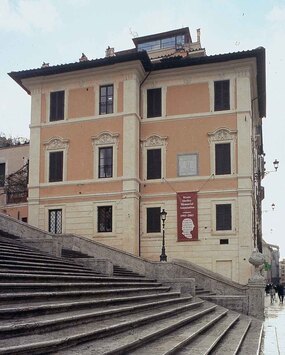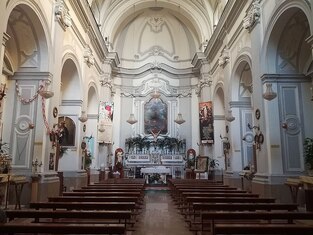An interesting find in Naples
I'm interrupting my "Clutching My Pearls" series for some exciting Shelley news!
The Journal of the Keats-Shelley Association for 2019, which came out this month, features an article by Donatella Sisti, which tells of her interesting discovery relating to the "Neapolitan Mystery." I used this mysterious episode in the life of poet Percy Bysshe Shelley in my novella and in my Mansfield Trilogy, so I was very excited to hear this article and couldn't wait to read it! I assume that the full article is available only to subscribers to the Keats-Shelley journal, or to people with library access, but there is a link here.  The Keats-Shelley Memorial Association maintains the house in which the poet John Keats died in Rome So Percy Bysshe Shelley either fathered or adopted a little girl in Naples in the winter of 1818/1819. We don't know if his wife Mary Shelley knew about this child, or how much she knew, but historians agree she could not have been the mother of the baby. My earlier posts will give a recap of the questions that linger around this child, who died before her second birthday.
The Keats-Shelley Memorial Association maintains the house in which the poet John Keats died in Rome So Percy Bysshe Shelley either fathered or adopted a little girl in Naples in the winter of 1818/1819. We don't know if his wife Mary Shelley knew about this child, or how much she knew, but historians agree she could not have been the mother of the baby. My earlier posts will give a recap of the questions that linger around this child, who died before her second birthday.
She was christened "Elena Adelaide Shelley" and she was evidently placed with a working-class Neapolitan family. She didn't live with the Shelleys and they were not in Naples when she died.
An enterprising scholar and Shelley enthusiast, Donatella Sisti, searched the national archives of Naples to see if she could find anything that would shed further light on the mystery. She had the name of the midwife from the birth certificate and the names of some working-class Neapolitans who served as witnesses for the death certificate. Sisti searched for these names in the archives, including the police reports, of the time but found nothing.
She then turned to the actual neighbourhood where Elena Adelaide lived. Aware that Naples would have had church parish records in addition to government archives, Sisti located the relevant church archives for the area--and found the burial certificate of Elena Adelaide. Her burial was conducted by the priests of the Church of Santi Francesco e Matteo (St. Francis of Assisi). How exciting to uncover this long-hidden document!
 Interior of the Church (Chiesa) dei Santi Francesco e Matteo, Naples, photo Wikicommons Sisti reports that the parish records gives the mother's name as "Maria Getwin," yet another variation on the mother's name, which appears to be an approximation of "Godwin," Mary Shelley's maiden name.
Interior of the Church (Chiesa) dei Santi Francesco e Matteo, Naples, photo Wikicommons Sisti reports that the parish records gives the mother's name as "Maria Getwin," yet another variation on the mother's name, which appears to be an approximation of "Godwin," Mary Shelley's maiden name.
The death certificate gives her age as consistent with the date her birth certificate was applied for, not the date on which she was supposedly born, which was December 27 (the older blog posts discuss this discrepancy).
Another question that intrigues me is, if the little girl died on June 10th, which seems incontrovertible, why did Shelley, who lived to the north of Naples at that time, still think she was merely ill in July? How long did it take for the bad news to reach him?
And was it a mere coincidence, that the "superlative rascal," Paolo Foggi, was ramping up his blackmail efforts at the exact same time? Did Foggi learn of Elena Adelaide's death before Shelley?
There is, as Sisti notes, no grave, no plaque, no place for people to leave a flower in Elena Adelaide's memory. Her bones are collected together with the bones of other children in a common ossuary.
I think that Sisti's discovery helps to settle the controversy of the mother's name in the birth, baptismal and death certificate. It is spelled differently in every instance, for example as "Padurin" and "Gebuin." Some, including me, have surmised that the mother's name was not given as "Godwin," others have argued that the variations are erroneous transcribings of "Godwin." I think this burial certificate naming the mother as "Maria Getwin" tilts the argument toward "Godwin."
It would be useful to know if listing the mother's maiden name, even if she was married, was routine in documents of this kind.
Shelley, his wife Mary, her sister Claire and their servants were all travelling around Italy, to Milan, Pisa, and Livorno, in the spring of 1818. They spent the summer at Bagni di Lucca, a spa town in Tuscany. If the child was born sometime during the winter of 1818/19, then she was conceived in May or June 1818. If Shelley was the father, as he claimed on the birth certificate, then the mother was also at one of those places before going to Naples.
I tell a fictional version of the Neapolitan mystery in my novella, Shelley and the Unknown Lady. A briefer version also appears in A Different Kind of Woman, the last novel in my Mansfield Trilogy.
Congratulations to Donatelli Sisti for uncovering this document and adding to Elena Adelaide's story!
I'll go back to clutching my pearls over Jane Austen in my next post.
The Journal of the Keats-Shelley Association for 2019, which came out this month, features an article by Donatella Sisti, which tells of her interesting discovery relating to the "Neapolitan Mystery." I used this mysterious episode in the life of poet Percy Bysshe Shelley in my novella and in my Mansfield Trilogy, so I was very excited to hear this article and couldn't wait to read it! I assume that the full article is available only to subscribers to the Keats-Shelley journal, or to people with library access, but there is a link here.
 The Keats-Shelley Memorial Association maintains the house in which the poet John Keats died in Rome So Percy Bysshe Shelley either fathered or adopted a little girl in Naples in the winter of 1818/1819. We don't know if his wife Mary Shelley knew about this child, or how much she knew, but historians agree she could not have been the mother of the baby. My earlier posts will give a recap of the questions that linger around this child, who died before her second birthday.
The Keats-Shelley Memorial Association maintains the house in which the poet John Keats died in Rome So Percy Bysshe Shelley either fathered or adopted a little girl in Naples in the winter of 1818/1819. We don't know if his wife Mary Shelley knew about this child, or how much she knew, but historians agree she could not have been the mother of the baby. My earlier posts will give a recap of the questions that linger around this child, who died before her second birthday.She was christened "Elena Adelaide Shelley" and she was evidently placed with a working-class Neapolitan family. She didn't live with the Shelleys and they were not in Naples when she died.
An enterprising scholar and Shelley enthusiast, Donatella Sisti, searched the national archives of Naples to see if she could find anything that would shed further light on the mystery. She had the name of the midwife from the birth certificate and the names of some working-class Neapolitans who served as witnesses for the death certificate. Sisti searched for these names in the archives, including the police reports, of the time but found nothing.
She then turned to the actual neighbourhood where Elena Adelaide lived. Aware that Naples would have had church parish records in addition to government archives, Sisti located the relevant church archives for the area--and found the burial certificate of Elena Adelaide. Her burial was conducted by the priests of the Church of Santi Francesco e Matteo (St. Francis of Assisi). How exciting to uncover this long-hidden document!
 Interior of the Church (Chiesa) dei Santi Francesco e Matteo, Naples, photo Wikicommons Sisti reports that the parish records gives the mother's name as "Maria Getwin," yet another variation on the mother's name, which appears to be an approximation of "Godwin," Mary Shelley's maiden name.
Interior of the Church (Chiesa) dei Santi Francesco e Matteo, Naples, photo Wikicommons Sisti reports that the parish records gives the mother's name as "Maria Getwin," yet another variation on the mother's name, which appears to be an approximation of "Godwin," Mary Shelley's maiden name.The death certificate gives her age as consistent with the date her birth certificate was applied for, not the date on which she was supposedly born, which was December 27 (the older blog posts discuss this discrepancy).
Another question that intrigues me is, if the little girl died on June 10th, which seems incontrovertible, why did Shelley, who lived to the north of Naples at that time, still think she was merely ill in July? How long did it take for the bad news to reach him?
And was it a mere coincidence, that the "superlative rascal," Paolo Foggi, was ramping up his blackmail efforts at the exact same time? Did Foggi learn of Elena Adelaide's death before Shelley?
There is, as Sisti notes, no grave, no plaque, no place for people to leave a flower in Elena Adelaide's memory. Her bones are collected together with the bones of other children in a common ossuary.
I think that Sisti's discovery helps to settle the controversy of the mother's name in the birth, baptismal and death certificate. It is spelled differently in every instance, for example as "Padurin" and "Gebuin." Some, including me, have surmised that the mother's name was not given as "Godwin," others have argued that the variations are erroneous transcribings of "Godwin." I think this burial certificate naming the mother as "Maria Getwin" tilts the argument toward "Godwin."
It would be useful to know if listing the mother's maiden name, even if she was married, was routine in documents of this kind.
Shelley, his wife Mary, her sister Claire and their servants were all travelling around Italy, to Milan, Pisa, and Livorno, in the spring of 1818. They spent the summer at Bagni di Lucca, a spa town in Tuscany. If the child was born sometime during the winter of 1818/19, then she was conceived in May or June 1818. If Shelley was the father, as he claimed on the birth certificate, then the mother was also at one of those places before going to Naples.
I tell a fictional version of the Neapolitan mystery in my novella, Shelley and the Unknown Lady. A briefer version also appears in A Different Kind of Woman, the last novel in my Mansfield Trilogy.
Congratulations to Donatelli Sisti for uncovering this document and adding to Elena Adelaide's story!
I'll go back to clutching my pearls over Jane Austen in my next post.
Published on November 23, 2020 00:00
No comments have been added yet.



